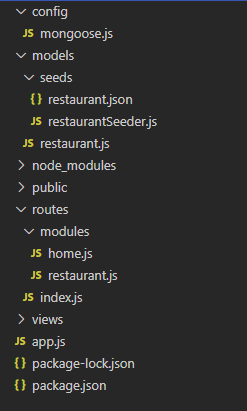從零開始重寫:餐廳清單(Express版)路由、METHODS重構
總結
本篇為餐廳清單(Express 版)的路由、METHODS 重構,以及使用browserify搭配axios實現 in-browser require()之相關筆記
環境
browserify: 17.0.0
os: Windows_NT 10.0.18363 win32 x64筆記

路由重構
app.js
- 第 6 行:將 DB 連線設定搬移到 config 資料夾中
- 13-15 行:為配合 axios 的 POST request,將
body-parser加回來 - 37-38 行:將路由移動到 routes 資料夾中
routes/index.js
- 4-5 行:routes/modules 中的 home.js 與 restaurants.js 皆分別在檔案結尾進行
module.exports = router,讓 index.js 可引用之 - 7-8 行:分別將對
/與/restaurant的請求導向home與restaurant - 第 10 行:將 index.js 本身也進行匯出,使 app.js 可使用之(app.js 中第 37 行)
METHODS 重構
-
參考 app.js 第 33-34 行,引用
method-override後,使用 override using a query value 的方式複寫 METHOD 官方說明:To use a query string value to override the method, specify the query string key as a string argument to the methodOverride function. To then make the call, send a POST request to a URL with the overridden method as the value of that query string key. This method of using a query value would typically be used in conjunction with plain HTML
<form>elements when trying to support legacy browsers but still use newer methods.官方示範程式碼:
const express = require('express'); const methodOverride = require('method-override'); const app = express(); // override with POST having ?_method=DELETE app.use(methodOverride('_method'));<form method="POST" action="/resource?_method=DELETE"> <button type="submit">Delete resource</button> </form> -
將 form action 設定完畢後,原本的 POST request 就會(根據 query string value)被覆寫為 DELETE 與 PUT 等 METHOD
-
之後即可在後端使用
router.delete或router.put等方式處理相關請求
browserify 流程記錄
- 安裝 browserify 與 axios
- 在 public/scripts 資料夾中建立一檔案 sort.js,內容如下
- 在沒有搭配 browserify 的情況下,直接引用 sort.js 檔案會在瀏覽器 console 看到
ReferenceError: require is not defined此錯誤訊息,相關討論參考:Client on Node.js: Uncaught ReferenceError: require is not defined - 參考 browserify 的GitHub README,在終端輸入
browserify public/scripts/sort.js > public/scripts/sortBundle.js將 sort.js 與 axios 等額外 require 的模組 bundle 在一起 - 最終在前端網頁引用
sortBundle.js此檔案,錯誤訊息消失,問題解決
補充
Method: PATCH, PUT
- A
PATCHrequest is considered a set of instructions on how to modify a resource. Contrast this withPUT; which is a complete representation of a resource. - A
PATCHis not necessarily idempotent, although it can be. Contrast this withPUT; which is always idempotent. The word “idempotent” means that any number of repeated, identical requests will leave the resource in the same state. (不像POSTrequest 如果連續發送可能會變成多筆訂單,多次發送PUTrequest 不會有類似的後遺症) - Calling
PUTmethod once or several times successively has the same effect (that is no side effect), this method is idempotent; whereas successive identicalPOSTrequests may have additional effects, akin to placing an order several times.
Idempotent
- Description of common idempotent methods: GET, HEAD, PUT, DELETE, OPTIONS, TRACE
- Description of common non-idempotent methods: POST,PATCH, CONNECT
- A request method is considered “idempotent” if the intended effect on the server of multiple identical requests with that method is the same as the effect for a single such request. (對 server 打一次或多次的結果如果都一樣,該 HTTP method 就會被認為是 idempotent) Of the request methods defined by this specification, PUT, DELETE, and safe request methods (GET, HEAD, OPTIONS) are idempotent.